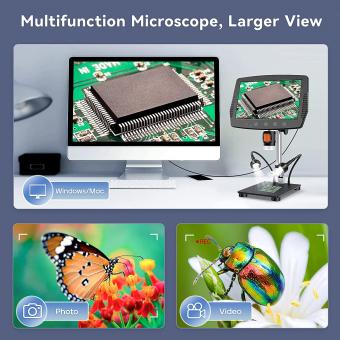Can You See Particles With A Microscope ?
Yes, a microscope can be used to see particles.
1、 Optical Microscopy: Limited resolution for observing larger particles.
Optical microscopy is a widely used technique for observing objects at the microscopic level. However, its ability to see particles is limited by its resolution, especially when it comes to smaller particles.
In optical microscopy, visible light is used to illuminate the sample, and the image is formed by the interaction of light with the sample. The resolution of an optical microscope is determined by the wavelength of light used and the numerical aperture of the objective lens. According to the Abbe diffraction limit, the resolution of an optical microscope is approximately half the wavelength of light used. This means that smaller particles, which have dimensions below the resolution limit, cannot be resolved and seen clearly.
However, larger particles can be observed with an optical microscope. The microscope can provide valuable information about the size, shape, and distribution of these particles. By adjusting the focus and magnification, researchers can obtain detailed images of larger particles and study their characteristics.
It is important to note that recent advancements in optical microscopy techniques have improved the resolution and capabilities of this method. Techniques such as confocal microscopy, super-resolution microscopy, and fluorescence microscopy have pushed the limits of optical microscopy, allowing for the visualization of smaller particles and structures. These techniques utilize various principles, such as the manipulation of light or the use of fluorescent labels, to enhance the resolution and contrast of the images.
In conclusion, while optical microscopy has limited resolution for observing smaller particles, it remains a valuable tool for studying larger particles. Recent advancements in microscopy techniques have expanded the capabilities of optical microscopy, enabling the visualization of smaller particles and structures.

2、 Electron Microscopy: Higher resolution for visualizing smaller particles.
Can you see particles with a microscope? Yes, you can see particles with a microscope, but the type of microscope used determines the resolution and size of particles that can be visualized. Traditional light microscopes, also known as optical microscopes, are limited in their ability to visualize particles smaller than the wavelength of visible light, which is around 400-700 nanometers. This means that particles smaller than this size cannot be resolved and seen clearly with a light microscope.
However, electron microscopy offers higher resolution for visualizing smaller particles. Electron microscopes use a beam of electrons instead of light to create an image, allowing for much higher magnification and resolution. There are two main types of electron microscopes: transmission electron microscopes (TEM) and scanning electron microscopes (SEM).
TEMs are used to visualize the internal structure of particles. They work by passing a beam of electrons through a thin sample, and the resulting image reveals the internal details of the particles. TEMs can achieve resolutions down to the atomic level, allowing scientists to see individual atoms and molecules.
On the other hand, SEMs are used to visualize the surface of particles. They work by scanning a focused beam of electrons across the sample's surface, and the resulting image provides a detailed topographical view of the particles. SEMs can achieve resolutions down to the nanometer scale, allowing scientists to see the surface features and morphology of particles.
In recent years, advancements in electron microscopy techniques have further improved the resolution and capabilities of these instruments. For example, aberration-corrected electron microscopy has significantly enhanced the resolution and image quality, enabling the visualization of even smaller particles and finer details.
In conclusion, while traditional light microscopes have limitations in visualizing particles smaller than the wavelength of visible light, electron microscopy offers higher resolution and the ability to see particles at the atomic and nanometer scale. Ongoing advancements in electron microscopy techniques continue to push the boundaries of what can be visualized, providing valuable insights into the world of particles and materials.

3、 Scanning Probe Microscopy: Imaging surfaces at atomic and molecular scales.
Yes, you can see particles with a microscope, specifically with a Scanning Probe Microscope (SPM). SPM is a powerful tool used to image surfaces at atomic and molecular scales. It allows scientists to observe and manipulate individual atoms and molecules, providing valuable insights into the structure and behavior of materials.
SPM works by scanning a sharp probe over the surface of a sample. The probe interacts with the surface, and the resulting signals are used to create a high-resolution image. There are different types of SPM, including Atomic Force Microscopy (AFM) and Scanning Tunneling Microscopy (STM), each with its own unique capabilities.
AFM is commonly used to visualize particles and surfaces with nanoscale resolution. It uses a small cantilever with a sharp tip to scan the surface. As the tip interacts with the sample, it experiences forces that are measured and used to create an image. AFM can provide topographic information, allowing researchers to see the shape and size of particles.
STM, on the other hand, is particularly useful for imaging conductive materials at the atomic scale. It relies on the quantum mechanical phenomenon of electron tunneling between the probe tip and the sample surface. By measuring the tunneling current, STM can create images that reveal the atomic arrangement of particles.
The latest advancements in SPM technology have further improved its capabilities. For example, high-speed AFM techniques have been developed, enabling real-time imaging of dynamic processes at the nanoscale. Additionally, functionalized tips and specialized imaging modes have expanded the range of information that can be obtained from SPM.
In conclusion, Scanning Probe Microscopy, such as AFM and STM, allows scientists to see particles at atomic and molecular scales. It provides valuable insights into the structure and behavior of materials, and recent advancements have further enhanced its capabilities.

4、 Fluorescence Microscopy: Detecting particles labeled with fluorescent markers.
Yes, you can see particles with a microscope, specifically with the use of Fluorescence Microscopy. This technique allows for the detection of particles that have been labeled with fluorescent markers. Fluorescent markers are molecules that emit light of a specific wavelength when excited by a particular light source.
In Fluorescence Microscopy, the sample is illuminated with a specific wavelength of light that excites the fluorescent markers attached to the particles of interest. These markers then emit light of a different wavelength, which is captured by the microscope and visualized. This allows for the visualization and detection of the particles, even at the microscopic level.
Fluorescence Microscopy has revolutionized the field of biological imaging, as it provides high sensitivity and specificity in detecting particles. It has been widely used in various research areas, including cell biology, immunology, and molecular biology. By labeling specific molecules or structures with fluorescent markers, researchers can study their localization, interactions, and dynamics within cells and tissues.
Moreover, recent advancements in Fluorescence Microscopy techniques, such as super-resolution microscopy, have further enhanced the ability to visualize particles at an even higher resolution. These techniques have pushed the limits of traditional microscopy and allowed for the visualization of structures and particles that were previously beyond the reach of conventional microscopes.
In conclusion, Fluorescence Microscopy is a powerful tool that enables the visualization and detection of particles labeled with fluorescent markers. It has greatly contributed to our understanding of biological processes and continues to evolve with new techniques and technologies.








































